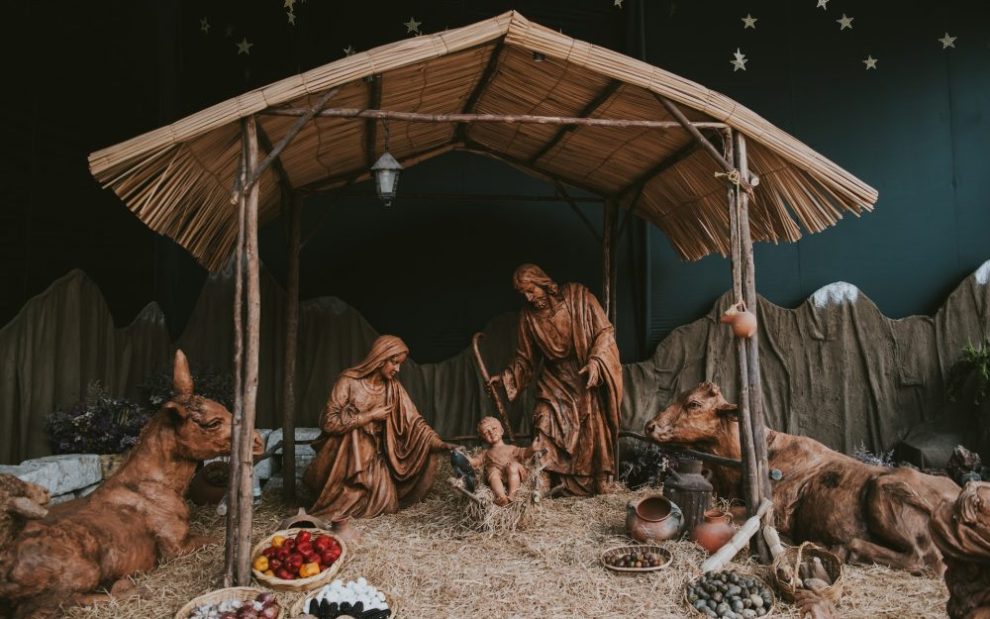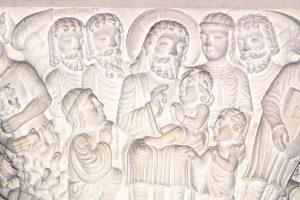I look out my front window and see the nativity scene in my neighbor’s yard. Another family a few doors down also has their crèche out, complete with a star hanging from the tree above it, before Thanksgiving. The iconic picture is familiar to most of us: Joseph alongside Mary, and the infant Jesus in a manger between them. They sit ringed by shepherds and some of their flock, three magi holding ornate gifts, at least one angel, and the bright star. The nativity set of my childhood also had a very docile-looking donkey. This is what the first Christmas Eve looked like, I was taught.
But liberties have been taken with the nativity narratives. There is not one seamless story about the birth of Jesus; there are two. These narratives have been harmonized, but the truth is that Luke and Matthew have very different stories about what happens when God arrives. Luke writes about Zechariah and Elizabeth in Jerusalem, Gabriel visiting Mary in Nazareth, and Mary and Joseph journeying down to Bethlehem where Jesus is born. And he tells of vigilant shepherds in the fields and singing angels overhead.
Matthew begins his story in Bethlehem, as if the soon-to-be parents live there. Here we learn of Joseph and his dreams. Here too is where we are introduced to the magi from the East and hear of their tense interaction with Herod, the current ruler of the region. Herod is the reason, Matthew tells us, that the holy family has to flee as political refugees to Egypt. He is the reason the innocents are slaughtered as he hunts for Jesus. It is a much darker story than Luke’s version. And the magi and their star are never in the same narrative as the shepherds or the angelic host announcing good tidings.
Another thing that may be misrepresented in these nativity narratives is the landscape. We tend to see the events playing out against a bucolic backdrop. But Luke makes clear that these are troubled times. The announcement of a mandatory imperial census that requires Joseph and Mary to travel south to his ancestral home means that their tax burden is about to increase. Caesar only counts people when he wants to calculate how much more tribute he can extract from them. So the hard economic times are about to get worse, and it must have weighted on Joseph as he makes his way to Bethlehem with his new bride. Luke wants us to see the economic duress, but we often miss the cues.
When the couple arrives at their destination, popular narratives depict an innkeeper who denies them entry because there is no room at the local inn. Some imagine that because none of the inns have room, Jesus is born in a cave tucked into one of Bethlehem’s many hills. But a closer reading reveals something quite different. Joseph would have had extended family in town, and they would have had a family compound. In such a compound there would be a structure with private and enclosed rooms (an “inn”), some covered but less private spaces, and a pen where the livestock stayed. The travel-weary couple are likely welcomed by their family into the compound, but there is no room inside (or in the “inn”), so they stay in a corner of the pen. But they are in the family compound, share in family meals, and are neither unwelcomed nor alone. One could imagine that when Mary goes into labor, all the aunts and cousins leap into action and function like midwives, helping the young girl through her first experience of childbirth. A better reading of Luke’s narrative shows no inhospitable innkeeper but plenty of family surrounding the holy family that night.
Out in the fields watching over the flocks are the shepherds, essential yet invisible. Since Bethlehem is the meat district of Judea, shepherds are the essential workers who tend the flocks and make it possible for animal products such as suet, wool, and meat to make it to the marketplace. For all their hard work, they are invisible to the elites of society. But they might be familiar folk to Joseph’s family, having more in common with them than not. And their inclusion in Luke’s narrative says something about a God who sees those we deem invisible—and even includes them in this natal story of our faith.
Matthew takes a different approach in his nativity narrative. There are no shepherds, angels, or mention of a census. He spends more time telling what happens after the birth of Jesus. An unknown number of magi journey from the East looking for hope. We know there are three gifts, and so emerges the assumption that one gift is brought by each magi. But this is just a guess on our part.
The magi follow a star, a celestial indicator that something divine is afoot. That is how they end up in a foreign territory and at Herod’s door in Jerusalem, looking for the next king. These men are not looking for a spiritual king, however, or a priest. They are looking for an indigenous ruler who will dethrone the foreign emperor and restore national sovereignty. If it could happen in Judea, maybe it could also happen in Persia, they hope. When they finally find the young child, they worship him. This is not a religious act, but a political one. They offer homage to the new king of Judea, the one who will bring true peace. And after their political pilgrimage, they return home with hope.
The nature of peace is one more thing to reconsider about the nativity narratives. We often sing about God bringing peace at this time of the year, extolling Jesus as the Prince of Peace. It is easy to assume that once Jesus is born, peace is finally inaugurated. But the Pax Romana is in full sway, Caesar having already achieved his own version of world peace. So maybe God’s arrival in Bethlehem is meant to inspire a critique of common understandings of peace. A peace that demands military might, exploits many people economically, and makes the world more insecure and riddled with pain is a pseudo peace.
God’s peace campaign comes on a birthstool, not a battlefield. This is a different kind of peace entirely. And this is where Luke and Matthew agree: God is offering a new kind of peace to those willing to reimagine the world through the eyes of this humble family trying to survive under the boot of the empire. It is a story of hardship and hard-borne hope. And it invites us to enter Advent anew.
Image: Unsplash/Walter Chávez














Add comment